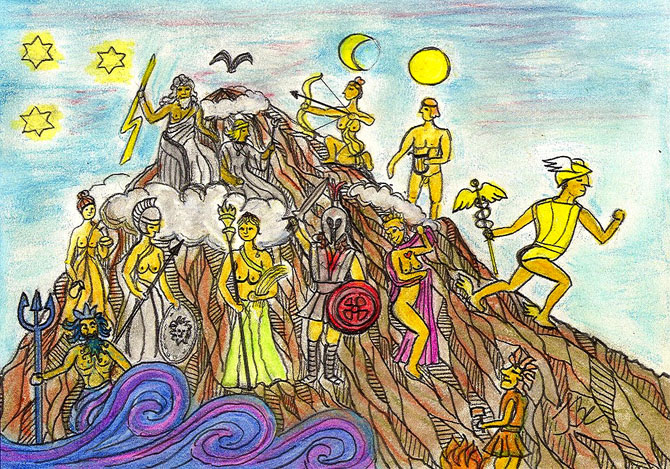TRIGRAMMS
The eight trigrams are called Bagua in Chinese and we find their origin in Chinese divination. There are 64 possible combinations of the eight trigrams. These 64 hexagrams make up the I Ching (Book of Transformations).
I Ching is believed to contain all the wisdom of the East. You can thus consult and receive guidance from the I Ching about – indeed, anything. The descriptions of the hexagrams are somewhat cryptic, which is why the I Ching is sometimes referred to as an oracle or a work of divination.
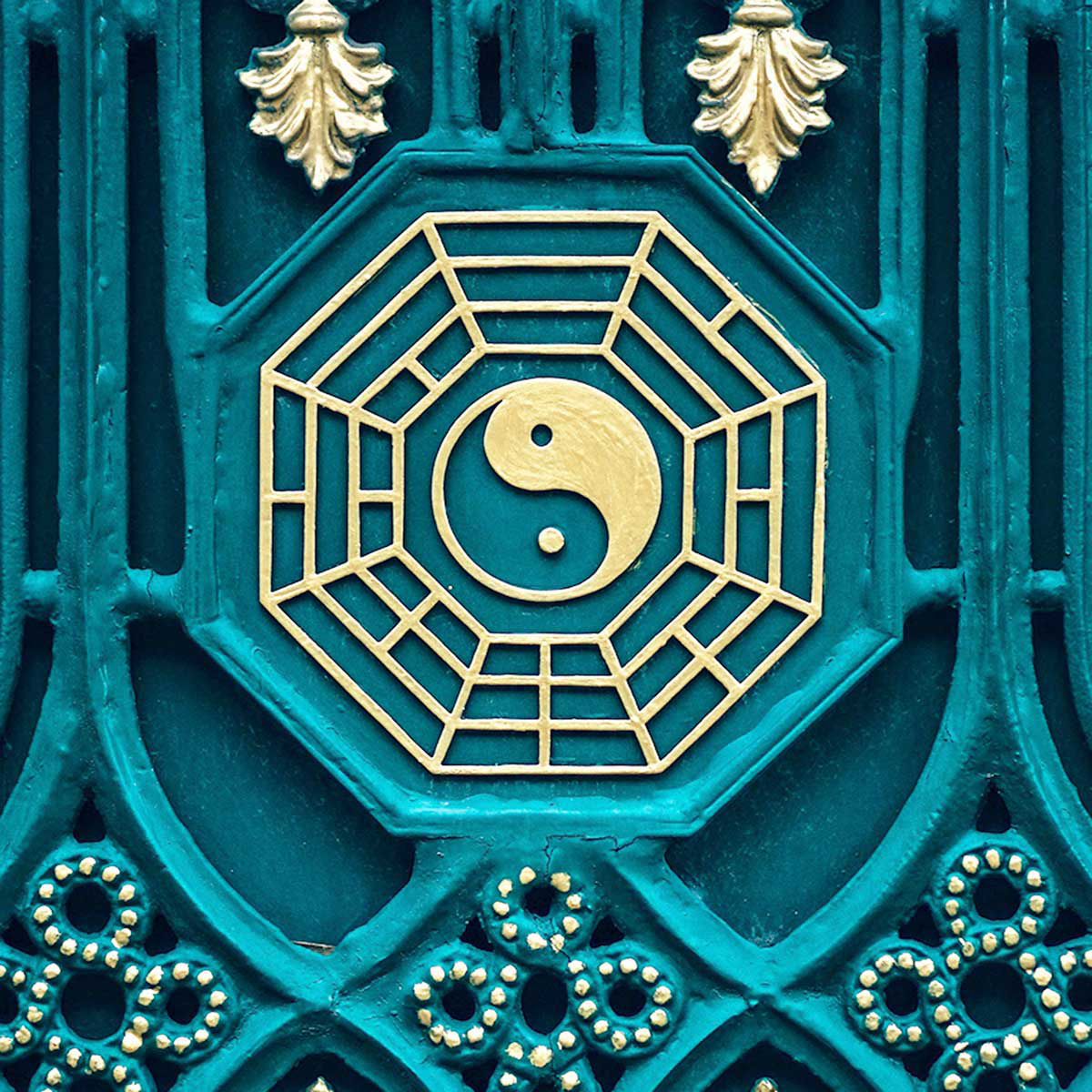
The ancient Chinese diviners liked to make fortunes by burning some bones and based their predictions on what the cracked (splintered) bones seem to represent. Other divination methods were to heat up a turtle shell and study the cracks that appear.
Since the art of divination was based on Yin-Yang, a broken line symbolized the female, negative and passive force Yin and the answer “No”, while an unbroken line symbolized the male, positive and active force Yang, and the answer “Yes”.
The limitation to these two answers was soon insufficient and it was therefore found to make some signs that each contained two lines, whereby the answer options were doubled to four. Later, another line was added and eight different options could now be formed.
These were called trigrams and different characteristics were attached to each of these. This evolution from four to eight options is attributed to someone we don’t know much about; Fu Hsi (or Pao Hsi), who lived around the year 2800 BC.
First we have Yang (an undivided line) and Yin (a broken line). By combining these two signs, you got four possible answers, and by combining these four signs again, you got eight possible answers – the trigrams. By combining the eight trigrams, you came up with 64 possible answers – the hexagrams.
The eight trigrams are called BaGua in Chinese and are thus eight figures with three lines in each, hence the name trigrams. Each line is either yin or yang.
![]()
Each trigram has a symbolic name that acts as a kind of heading for the eight categories that according to the I Ching and Chinese astrology everything can be divided into. Since everything can be classified into one of the eight categories, everything becomes able to be related to each other in a extensive correlation system – whereby the eight trigrams come to form part of a system, with a rather extensive range.
However, trigrams are not simply a classification of things; they also explain the sequence in which the transformations proceed. Each of the eight trigrams is a direction, an image, a state, etc. In China, these trigrams are considered symbols representing all possible cosmic and human situations.
Via trigrams, the I Ching divides everything into eight categories. For example, the body: head, stomach, feet, thighs, ears, eyes, hands and mouth. And the Family: Father, mother, eldest son, eldest daughter, middle son, middle daughter, youngest son and youngest daughter.
In order to understand the meaning of the individual trigrams’ association with, for example, a family role, you must think about what this role entails. Perhaps not so much in today’s family pattern, but in the family pattern that existed when the Ching was written.
The father is the one who traditionally rules over a home. The first or eldest son is the one who started a new generation and provided for the parents and ancestors. Second or middle son, brave and bold, who must take chances, leave home or establish a new venture. Third or youngest son, the limit and end of the family.
Likewise with the daughters. Here, the first-born daughter is also considered to be the first to be married off and to preside over the new home. Second or middle daughter, traditionally has the role of mature, supportive and dependent. While the third or youngest daughter, who is usually carefree, capricious and magical.
The corners of the world and the four intermediate points south-east, north-west etc. are also correlated to the trigrams, well, in short, everything can be classified in relation to the eight trigrams.
![]()
But the trigrams do not simply describe a classification of things; they also explain the sequence in which the transformations proceed. There are two ways of placing the eight trigrams in relation to each other.
The former
heavenly order
Before Heaven | Xiantiantu
In this arrangement, the trigrams and the individual forces are in perfect balance. The opposites are placed opposite each other (Yin-Yang). Heaven is placed opposite earth, fire opposite thunder, etc. It is a stationary arrangement. The individual forces keep each other in check. This is good for illustrating the patterns of the energies, but not how they work and move.
The later
heavenly order
After Heaven | Houtiantu
In this arrangement, the trigrams and the individual forces are arranged according to the way in which they follow one another. The way they interact with each other creates a recurring cycle.
For example, the trigram K’an, the element water, has the property dangerous and thus expresses the depth of the abyss, difficulties. We are here in the middle of winter and it is dark.
This trigram is followed by the trigram Kên, the element mountain, the attribute resting, expressing the stillness of late winter and the tranquility of the mountain. We are here on the eve of spring, the trigram Zhen, when everything in nature begins to sprout. The diagram describes the passage of the year (clockwise) starting with Zhen in the east.
During a calendar year, the trigrams follow each other in this sequence and ‘rule’ over 45 days each, resulting in a 360-day year. That all things are constantly in a process of transformation into something else is the fundamental thought of the I Ching.
“When the sun goes away, the moon comes. When the moon goes away, the sun comes. Sun and moon make room for each other, and the light arises from this. When winter goes away, summer comes. When summer goes away, winter comes.
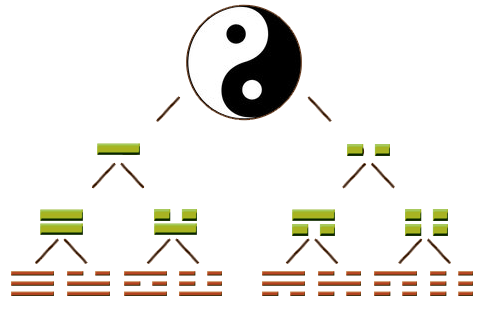
This interaction between the opposite poles of the universe and nature is often described in terms of the concepts of yin and yang. In the same way that yin and yang are aspects of the whole, the eight trigrams are aspects of yin and yang. And in the same way that everything can be classified and ordered according to yin and yang, everything can be ordered according to the trigrams.
The most important thing to understand about trigrams is that via their association with all sorts of categories such as the family, compass directions, colors, Kua number, the five elements, the twelve animal signs, seasons, time, etc. – will be part of a system, with extensive scope.
Since everything can be classified into one of the eight categories, everything will be able to be related to each other in a comprehensive correlation system.
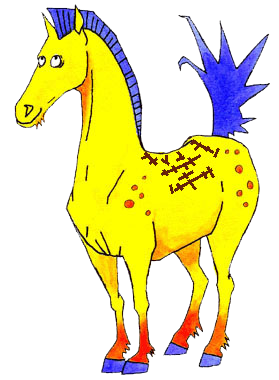 Origin of The former celestial order of the eight trigrams, attributed to Fu Hsi, Fuxi (伏羲), who together with his sister Nüwa is credited with inventing hunting, fishing, cooking and the Chinese written language.
Origin of The former celestial order of the eight trigrams, attributed to Fu Hsi, Fuxi (伏羲), who together with his sister Nüwa is credited with inventing hunting, fishing, cooking and the Chinese written language.
Legend says that Fu Hsi saw a horse on whose back there were dots arranged in a pattern called Ho-tu. In Chinese philosophy they say that when you understand the meaning of this pattern, you understand the structure of the universe.
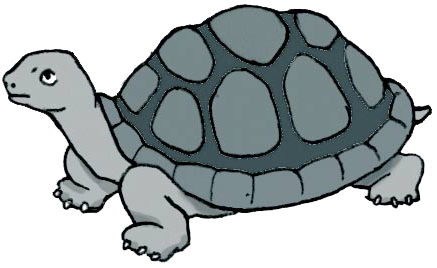 Origin of The later celestial order of the eight trigrams, attributed to the Chinese Yu Hsia there in 2205 B.C. saw a turtle emerge from the river Lo and on the turtle’s shield were listed nine numbers in a grid. The nine numbers were arranged in such a way that the result, when you added the numbers horizontally, vertically or diagonally, was always 15. This became known as the magical Lo Shu square and is the pattern underlying the Later Heavenly Order.
Origin of The later celestial order of the eight trigrams, attributed to the Chinese Yu Hsia there in 2205 B.C. saw a turtle emerge from the river Lo and on the turtle’s shield were listed nine numbers in a grid. The nine numbers were arranged in such a way that the result, when you added the numbers horizontally, vertically or diagonally, was always 15. This became known as the magical Lo Shu square and is the pattern underlying the Later Heavenly Order.
Each of the 64 hexagrams has a name and a meaning that you can look up in the book I Ching. Two texts are attached to each hexagram: one that comments on the hexagram, and one that comments on the individual lines in the hexagram. Furthermore, interpretation is based on the meaning of the trigrams from which the hexagram is formed.
As an example, we can take hexagram No. 12, called P’i, which is formed from the trigrams Ch’ien, the purely male, and K’un, the purely female.
As the strong is carried by the weak (Ch’ien is at the top) this means stagnation or standstill due to malevolent people. The commentaries add: “The heavenly and earthly forces are not connected with each other and everything is confused and disordered“.
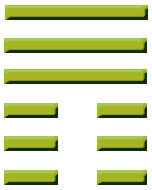 If the two trigrams are exchanged, we get the hexagram T’ai, where the female rests on the male.
If the two trigrams are exchanged, we get the hexagram T’ai, where the female rests on the male.
Here the text says: “Peace, harmony, heaven and earth unite, happiness, luck“. Between these two extremes the trigrams are joined in varying degrees of harmony or discord.
The description from the I Ching of the first trigram: “A dragon, a creative spirit that lives in the waters and sky, a dynamic shape-shifter. Creative power and strength to endure in time”. The description deals with what is associated with the trigram of properties.
The one who must interpret the I Ching thus has several different elements to help him – the interpretation of the two trigrams from which the hexagram is formed, the judgments and images The Book of Transformations links to the hexagram, interpretation of the lines of the hexagram as well as the shape of the individual hexagram and its shadow hexagram,
It is through the intuitive interpretation of these elements that the I Ching makes available that people according to The I Ching can teach you to act rightly in life’s situations.
However, this is easier said than done! The I Ching is believed to contain several centuries of Eastern wisdom, compressed into 64 hexagrams, which is why it is obviously not possible to quickly and easily achieve a deeper understanding of the work and the answers it wants to give you.
Let’s take a closer look at what we actually learn about the hexagram Ch’ien / The creative, the creative.
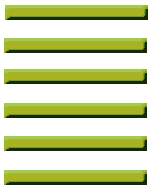 Overall, we actually get a whole little life story. We start in the bottom line with the untested, not yet mature man (or woman) and follow up through the hexagram this development towards becoming a great man.
Overall, we actually get a whole little life story. We start in the bottom line with the untested, not yet mature man (or woman) and follow up through the hexagram this development towards becoming a great man.
We start from the bottom line and move up towards the sky (Tao). It is said that the creative energy when it is in the lower line is hidden, i.e. internal, but that as you approach the sky, i.e. go up through the hexagram, you meet light that causes the germinating seeds to grow.
Various dangers lurk along the way. He (or she) can, for example, be misled when the masses begin to notice the talents and thus come to go after the external – wealth, fame etc. – or choose to continue with his studies as the lonely professor in his laboratory.
It is important to be aware that the hexagram does not indicate some of the paths as the only correct ones.
You could immediately imagine that there was something about it being the right thing to turn your energies inward and concentrate on becoming wise. But this the hexagram says or rejects very clearly by repeatedly using the phrase “Go without shame”. So when you have made a decision, it is right for you and you have nothing to be ashamed of.
When the person in the story has risen to the higher ranks and has gained a great position, power, influence and the like, the hexagram warns not to fly higher than the wings can carry. You can say that in this way it ends where it started, namely with an admonition that you must be careful not to throw yourself into something you cannot control.
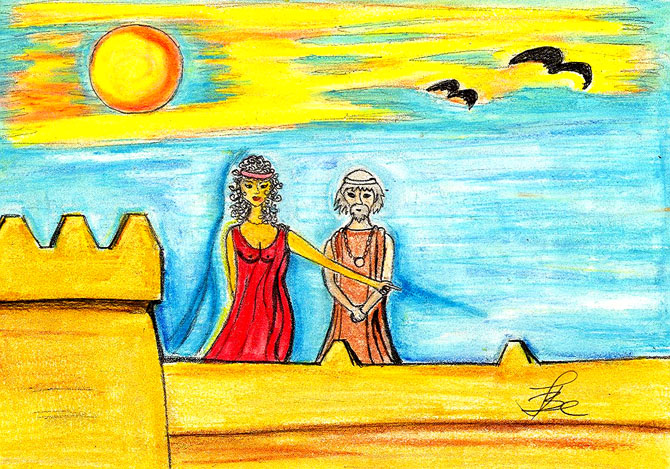
Sometimes the I Ching is seen simplified and simplistic. The answer from the hexagram Ch’ien can be explained as:
Presence of inspiration, energy and will. Entrepreneurship gathers around the imperative. You are considered a leader/advisor and can exercise influence. Know when not to trade. You become the center of personal contacts that appeal to your leadership. Future success.
Here we seek to take the essence of the hexagram and give you the answer. Which can be fine, but if you want a deeper understanding of the I Ching and the answers that the work seeks to give you, you must be aware of the use of associations and metaphors.
In Homer’s Illiad, he tells about the beautiful Helen, who is the starting point for the entire war about Troy. But nowhere does Homer write anything about Helena’s height, hair color, eye color or any characteristics of Helena in general – Homer is content simply to write that she is the most beautiful of the most beautiful.
And thereby leave it up to the reader to form his own opinion about what he/she thinks the most beautiful of the most beautiful looks like. In the same way the I Ching works. The answers are precisely cryptic and full of associations and metaphors so that the individual who consults the I Ching must find his own individual answer.
In order to therefore get the best possible out of the I Ching, it is essential to “know yourself”. To be aware that we humans see the world through each of our sets of glasses. We see and hear and read what we ourselves want. We see what we want to see.
One way in which you can gain an understanding of the eight trigrams and through this the hexagrams, the I Ching, is by looking at the eight areas of life. Via the BāGuàen you can find which parts of your home represent the different areas of your life and then you promote the individual areas by making the advice that the BāGuàn attributes.
Here we are thus entering the art of home decoration Feng Shui, which is however only a challenge for Westerners who are in a hurry to systematize and divide everything.
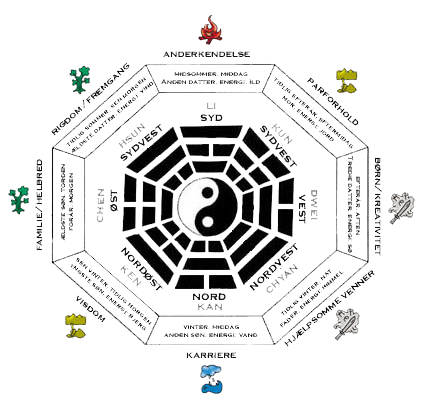
An Easterner does not need to separate the I Ching from Feng Shui, nor does he see much sense in doing so. According to Eastern thinking, there is not much wisdom in detaching and practicing everything as independent disciplines with step-by-step instructions.
Everything in the universe is perceived as a node for many relationships, and therefore the Easterner believes that nothing can simply be reduced to a point in space or a moment in time. Everything is seen in context and nothing can exist alone, as everything is part of, and considered as prerequisites for, each other.
Easterners perceive time as major and minor cycles that repeat. Everything returns to its starting point and you feel connected to this dynamic. In fact, so much so that the individual personality and the perception of an “I” merge with it, being part of a larger context.
As you feel part of larger contexts in time and space, you also have long-term interests. Overall, everyone must do their part to ensure that stability and harmony prevail in the universe at all times. You feel obliged to get the best possible out of your current life, but you also have a very strong interest in creating the greatest possible progress, welfare and harmony in the long term.
The ethics that prevail in the East come from the fact that Eastern people define themselves, their destiny and happiness, based on the communities they belong to – and this view is built on ancient traditions, but indeed also on a social system that concretely realizes the benefits of following and honoring the community over one’s own individual interests. The idea of community makes an Easterner instinctively look for similarity rather than difference.
This is in many ways the opposite of the view of humanity that abounds in the West. Here the individual person is perceived as detached, independent and, alone, responsible for his fate and happiness.
The logic of the East is “both-and” while the logic of the West is “either-or”. These fundamental differences are important to bear in mind when consulting the I Ching and seeking advice from the hexagrams.
Insisting on westernizing the I Ching, drawing boundaries between what are perceived as different disciplines, choosing one over the other, categorizing everything into separate boxes….yes, then you use the I Ching in a different way way than the work was intended!
 Ask I Ching Ask I Chingabout love |
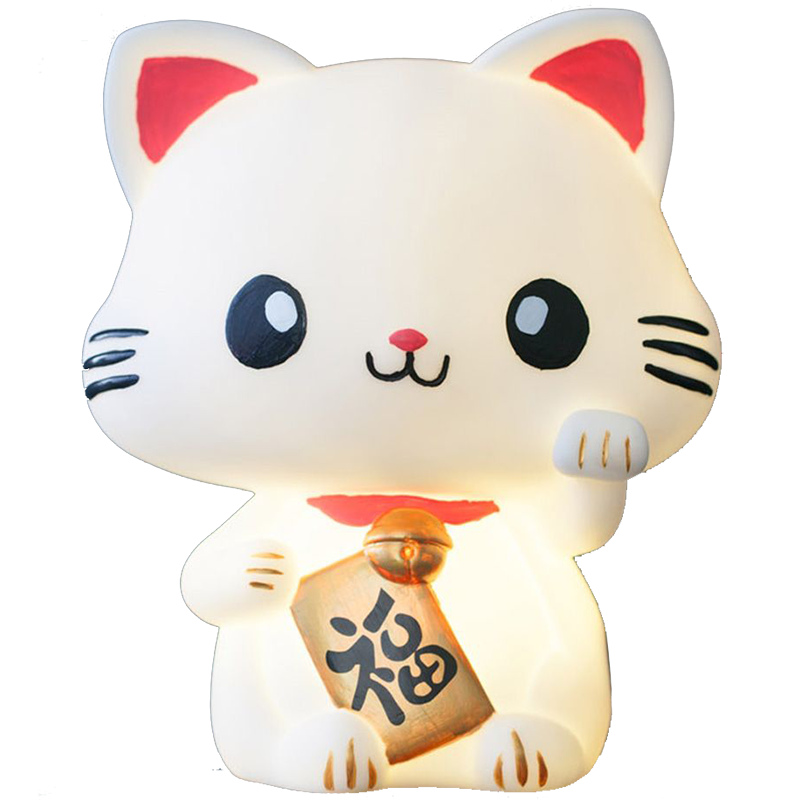 Ask I Ching
Ask I Chingabout business |
I CHING
Book of changes








